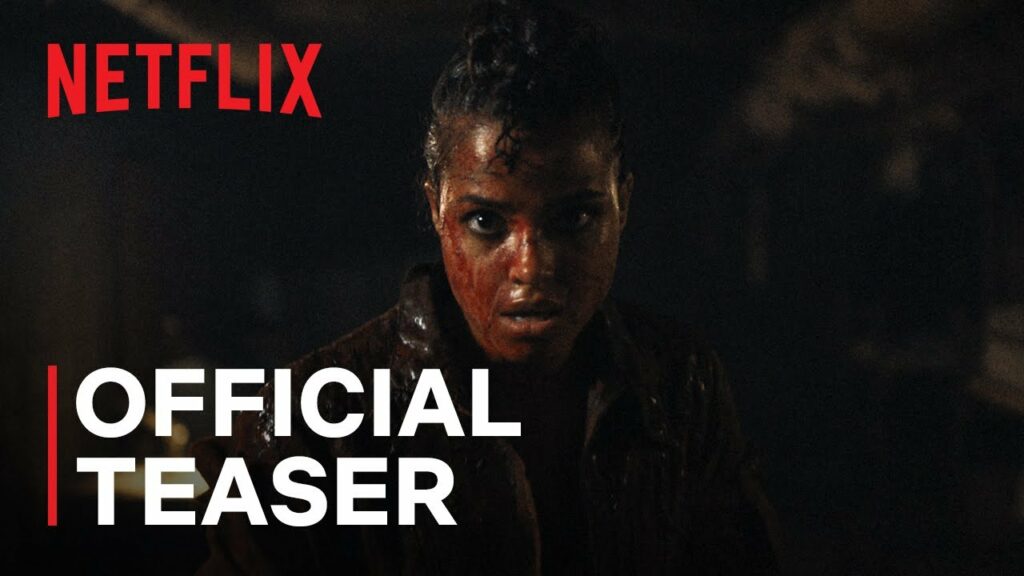Resident Evil Netflix TV Series Official Teaser Trailers 1 & 2
Resident Evil Netflix TV Series Official Teaser Trailers 1 & 2

Nothing eventful ever happens in the peaceful New Raccoon City. The legendary franchise Resident Evil brings its battle for survival to Netflix on July 14th.
Resident Evil Netflix Teaser 2
Available Now Resident Evil 12 Disc Box Set
Resident Evil 4K UHD Collection (12 Discs – UHD & BD) – Resident Evil / Apocalypse/ Extinction / Afterlife / Retribution / The Final Chapter [Blu-ray] [2020]
The “Resident Evil” franchise has returned from the dead in the first trailer for the next horror series on Netflix, which was released less than a year after the debut of its most recent live-action adaptation.
Lance Reddick stars as Albert Wesker, one of the primary antagonists from the first video game series, in the film adaptation of the long-running survival horror genre Capcom. “Resident Evil” is based on the franchise. Siena Agudong, Adeline Rudolph, Paola Nuez, Ahad Raza Mir, Connor Gossatti, and Turlough Convery are also a part of the cast in unknown roles. Tamara Smart and Ella Balinska play the younger and older versions of Wesker’s daughter Jade, respectively.
The storyline for the new series has been kept under wraps; however, the teaser trailer, which is set to the renowned 1971 pop song “I’d Like to Teach the World to Sing (In Perfect Harmony),” hints that the show will be split in between two different historical periods. The first story takes place in 2022 and follows Jade as she travels to the innovative city of New Raccoon City with her father and her sister Billy. Even though her surroundings first appear to be perfect, Jade gradually comes to realise that both her father and the Umbrella Corporation, which is responsible for running New Raccoon City, are keeping harmful secrets from her. In the second instalment, which takes place in the year 2036, players follow Jade as she travels across a post-apocalyptic version of London and battles for her life against the bloodthirsty infected victims of a global outbreak created by the Umbrella Corporation.
The long-running Capcom survival horror genre has spawned a number of successful adaptations, the most recent of which is this series. In the past, the series served as the inspiration for a total of six feature films, all of which were directed and produced by Paul W. S. Anderson and released between the years 2002 and 2016. The series featured various characters from the original games but did not follow the stories of the games itself. Milla Jovovich played the role of Alice, the original character, in the series. “Welcome to Raccoon City,” a revival of the show starring Kaya Scodelario and Tom Hopper, made its debut the previous year to a variety of reviews. Additionally, the series has been adapted into three Japanese animated films, and a computer-generated animated miniseries titled “Infinite Darkness” was released on Netflix in the previous year.
Andrew Dabb, who is most known for his work on the critically acclaimed CW series “Supernatural,” is the showrunner for the new series on Netflix. Together with Mary Leah Sutton, he writes and serves as an executive producer on shows. Constantin Film is the studio that is responsible for producing the series, and Robert Kulzer and Oliver Berben are serving as executive producers for the company.
The “Resident Evil” video game series, which debuted in 1996 with the first Playstation video game and follows a rotating cast of heroes as they investigate the misdeeds of the Umbrella Corporation, was directed by Shinji Mikami and produced by Tokuro Fujiwara. The series follows a rotating cast of heroes as they investigate the misdeeds of the Umbrella Corporation. The franchise has become one of the highest-grossing video game brands in the world, with sales of over 120 million units throughout the globe. Since its inception, the series has seen the release of 13 core games and various spinoffs. The most recent video game, “Resident Evil Village,” was launched the year before to widespread acclaim from reviewers.
About Resident Evil
Capcom is responsible for developing the horror-themed video game series and media franchise known as Resident Evil, which is known as Biohazard in Japan. It includes games in the survival horror, first-person shooter, and third-person shooter genres, respectively. A live-action film series, animated film series, television series, comic books, novels, audio dramas, and other forms of media and merchandising have all been introduced as part of the franchise’s expansion.
Shinji Mikami and Tokuro Fujiwara are credited as the game’s creators, and it was initially made available for the PlayStation in the year 1996. It is credited with defining the survival horror genre and bringing zombies back into mainstream culture after an absence of several decades. The franchise made the transition to more dynamic shooting action with the release of Resident Evil 4 in 2005. This game had an influence on the development of the survival horror and third-person genres, and it helped popularise the “over-the-shoulder” third-person view. The series switched to a first-person perspective with the release of Resident Evil 7: Biohazard (2017).
With 123 million units sold all over the world as of December 2021, the Resident Evil video game franchise is Capcom’s best-selling video game series. In addition to the fact that the film adaptations are the highest-grossing live-action video game film series, Resident Evil is the highest-grossing franchise in both the horror and zombie genres. The game series is the best-selling horror game series, and the films are the highest-grossing live-action video game film series.
In 1993, Tokuro Fujiwara of Capcom told Shinji Mikami and his coworkers to create a game incorporating aspects from Fujiwara’s 1989 game Sweet Home. This was the beginning of the development of the original Resident Evil game, which was launched in Japan under the name Biohazard. It was pointed out to the marketing executives who were setting up to release Biohazard in the United States in late 1994 that it would be very difficult to secure the rights to the name Biohazard because a DOS game had been registered under that name as well as a New York hardcore punk band called Biohazard. This presented a challenge for the marketing executives who were attempting to release Biohazard in the United States. The employees of the studio participated in a competition to select a new name for the game; the winner of this competition was Resident Evil, the name under which it was distributed in western markets. The first version of Resident Evil was released for the PlayStation in 1996. Subsequently, the game was adapted for use on the Sega Saturn.
The first game in the series was the first video game to be dubbed a “survival horror,” a term that was coined for the new genre that it initiated. As a result of the game’s critical and commercial success, it spawned two sequels for the PlayStation: Resident Evil 2 in 1998 and Resident Evil 3: Nemesis in 1999. On the Nintendo 64, a version of Resident Evil 2 was ported over from another system. Additionally, ports of all three were made available for use on computers running Microsoft Windows. The porting of Resident Evil 2 and Resident Evil 3: Nemesis came after the release of the fourth game in the series, Resident Evil – Code: Veronica, which was produced for the Dreamcast and made available to the public in the year 2000. Code: Veronica Complete is the revised version of Resident Evil – Code: Veronica that was later made available for the Dreamcast in Japan. This version featured some minor tweaks, the most of which centred on the game’s cutscenes and other narrative elements. Under the name Code: Veronica X, a subsequent port of this improved version was released on the PlayStation 2 and GameCube.
Shinji Mikami, the creator and producer of the series, made the decision to develop the series solely for the GameCube despite the fact that it had been previously stated that the next game in the series would be released for the PlayStation 2. This announcement led to the development of a game with no connection to the series titled Devil May Cry. The next three instalments in the series—a remake of the first Resident Evil game, which was released in 2002, the prequel Resident Evil Zero, which was also released in 2002, and Resident Evil 4, which was released in 2005—were all first made available only for the GameCube. Later on, Resident Evil 4 was made available for the PlayStation 2, Windows, and the Wii.
First-person gameplay was available in all three entries in the Gun Survivor series of light gun games, which were compatible with the GunCon system. The first instalment, titled Resident Evil Survivor and available for the PlayStation and personal computer, was launched in the year 2000 but was met with mixed reviews. The sequels, Resident Evil Survivor 2: Code: Veronica and Resident Evil: Dead Aim, performed a little bit better than the original game. In Japan, Dead Aim is the fourth instalment in the Gun Survivor series, with Gun Survivor 3 being the spin-off game Dino Stalker based on Dino Crisis. In a manner analogous to this, the gameplay in the Chronicles series is presented in the first person, albeit along a predetermined course. 2007 saw the release of Resident Evil: The Umbrella Chronicles for the Wii, followed by Resident Evil: The Darkside Chronicles in 2009. Both games are in the Resident Evil series (both were later ported to the PlayStation 3 in 2012). Despite receiving a generally negative review from players, Resident Evil 5 went on to become the series’ best-selling video game and was released in 2009 for the PlayStation 3, Windows, and Xbox 360 platforms.
An online game called Resident Evil Outbreak was released for the PlayStation 2 in 2003. It depicts a series of episodic narratives that take place in Raccoon City during the same time period as Resident Evil 2 and Resident Evil 3: Nemesis. It was the first instalment in the series as well as the first survival horror video game to offer cooperative gameplay. The next year, Resident Evil Outbreak: File #2, the sequel, was released. Raccoon City is a major city that was located in the Arklay Mountains in the central region of the United States. Unfortunately, it was unable to withstand the deadly T-virus outbreak and was consequently obliterated by a nuclear missile strike ordered by the federal government of the United States. The town was an important turning point in the story’s development because it was one of the primary factors that led to the collapse of Umbrella and it was also the starting point for the majority of the story’s most memorable characters.
A fighting system based on role-playing games is featured in the action-adventure video game Resident Evil Gaiden, which is available for the Game Boy Color. The Resident Evil series has been adapted into a number of different downloadable mobile games that have been released in Japan. T-Mobile has been responsible for the distribution of some of these mobile games in both North America and Europe. At the Sony press conference held during E3 2009, Resident Evil Portable was unveiled for the PlayStation Portable. It was characterised as an all-new title that was being built with “the PSP Go in mind,” and as being “completely different for a Resident Evil game.” There has been no additional communication regarding the game, thus it is now being treated as though it has been cancelled.
Resident Evil: Operation Raccoon City, a first-person shooter video game that was developed by Slant Six Games and published by Capcom in March 2012 for the PlayStation 3, Xbox 360, and Microsoft Windows, was one of the games unveiled by Capcom. Resident Evil: Revelations is a video game for the Nintendo 3DS that was released in February of 2012. It is a survival horror game. The following numbered instalment in the main series, Resident Evil 6, was published in October of the same year to mixed reviews but high pre-order sales.
In 2013, the producer Masachika Kawata stated that the Resident Evil franchise would return with a greater emphasis on scary and suspenseful moments than on action, and he added that this would be the case going forward “Survival horror as a genre will never reach the same level of financial success as shooters and other types of games that are significantly more popular and mainstream. At the same time, I believe that we need to have the courage to put money behind these initiatives, and it doesn’t mean that we can’t focus on what we need to achieve as a survival horror game to fulfil the requirements of our fans.” In March of 2015, the release of Resident Evil: Revelations 2, an episodic video game that takes place between Resident Evil 5 and Resident Evil 6, was announced. Umbrella Corps, a team-based multiplayer game that is situated in the same universe as the series and was published in June of 2016, has gotten a generally negative reception.
In January of 2017, Resident Evil 7: Biohazard was made available for purchase on Windows, the PlayStation 4, and Xbox One. The game takes place in a run-down mansion in Louisiana, and it utilises the first-person perspective. It also restores the franchise to its beginnings as a survival horror game. The gameplay, in contrast to that of Resident Evil 5 and Resident Evil 6, places more of an emphasis on horror and exploration than action.
On January 25, 2019, a reimagined version of Resident Evil 2 was made available for purchase on PlayStation 4, Windows, and Xbox One. It runs on the RE Engine, which was previously utilised for Resident Evil 7 in its previous iteration. Within a year, the sales of the remade game surpassed those of the original game by more than five million copies. A remake of Resident Evil 3: Nemesis, simply titled Resident Evil 3, was announced by Capcom in December 2019, following in the footsteps of the critically acclaimed remake of Resident Evil 2. Alongside the launch of Resident Evil: Resistance, a team-based online multiplayer game formerly known as Project Resistance, it was made available to the public on April 3, 2020.
Directly following up on the events of Resident Evil 7: Biohazard, Resident Evil Village is scheduled for release on May 7, 2021. The game takes place in a mysterious village in Europe and features the same first-person gameplay as its predecessor while also incorporating action elements from Resident Evil 4. In addition, the franchise makes its debut on the PlayStation 5 and Xbox Series X/S with this game.
About Netflix:
Netflix is the most popular online streaming entertainment service in the world. The company has 222 million paid subscribers in over 190 countries who watch TV series, documentaries, feature films, and mobile games in a wide variety of genres and languages. On any screen that is connected to the internet, subscribers are free to view as much as they want, whenever they want, wherever they want. Members are not required to watch any advertisements or make any commitments in order to play, pause, or resume watching content.
Resident Evil | Official Teaser | Netflix
https://youtube.com/Netflix
#ResidentEvil #Netflix Official Teaser #Trailers 1 & 2
Follow us for New Content Daily
Web – www.epicheroes.com
Twitter @epicheroes
Insta @epicheroesuk
http://www.youtube.com/c/Epicheroes
Resident Evil Netflix , Horror TV Series New
 Epic Heroes Entertainment Movies Toys TV Video Games News Art Pop culture news goodness
Epic Heroes Entertainment Movies Toys TV Video Games News Art Pop culture news goodness



